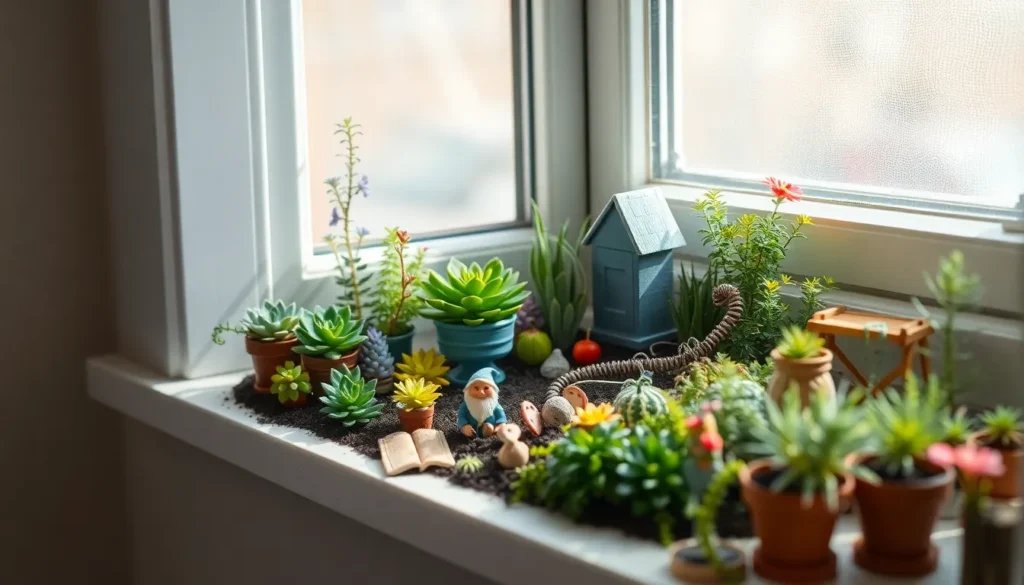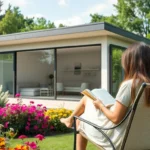We’ve all dreamed of having our own magical garden space but let’s face it – not everyone has acres of land to work with. That’s where miniature gardens come to the rescue! These tiny wonderlands pack all the charm and beauty of a full-sized garden into compact spaces that fit perfectly on windowsills tabletops or even inside glass containers.
Whether you’re living in a cramped apartment or simply want to add some green magic to your home office miniature gardens offer endless possibilities for creativity. From fairy tale landscapes complete with tiny bridges and cottages to zen-inspired succulent arrangements these small-scale gardens deliver maximum impact with minimal space requirements.
We’re excited to share innovative ideas that’ll transform any corner of your home into a captivating miniature paradise. You’ll discover how easy it is to create stunning displays that not only beautify your space but also provide the therapeutic benefits of gardening without the overwhelming commitment of maintaining a large outdoor garden.
Container Garden Ideas for Miniature Garden Spaces
Choosing the right container transforms your miniature garden from ordinary to extraordinary. We’ve discovered that the perfect vessel can enhance your tiny industry while providing proper growing conditions for your plants.
Repurposed Household Items as Planters
Vintage teacups and saucers create charming fairy garden settings with their delicate patterns and compact size. We love using these porcelain beauties for single succulent displays or tiny herb gardens that fit perfectly on kitchen windowsills.
Old colanders and strainers work wonderfully for miniature gardens requiring excellent drainage. Their built-in holes prevent waterlogging while adding rustic charm to your display.
Wooden drawers from antique furniture provide ample space for larger miniature landscapes. We’ve transformed these rectangular containers into complete garden scenes with pathways, tiny structures, and multiple plant varieties.
Glass jars and mason jars offer transparent viewing of root systems and soil layers. These containers work particularly well for closed terrarium environments where humidity levels stay consistent.
Repurposed tin cans and food containers become budget-friendly planters with proper drainage holes added. We recommend painting or decorating these containers to match your home’s aesthetic.
Traditional Pots and Planters for Small Gardens
Shallow ceramic bowls provide ideal growing conditions for succulent arrangements and desert-themed miniature gardens. Their wide surface area allows for creative plant positioning and decorative element placement.
Terra cotta pots in various sizes offer excellent breathability for plant roots while maintaining classic garden appeal. We suggest using 4-inch to 8-inch pots for most miniature garden projects.
Glazed ceramic planters come in countless colors and patterns to complement any interior design scheme. These containers retain moisture longer than unglazed options, making them perfect for plants requiring consistent watering.
Rectangular window boxes maximize growing space while fitting perfectly on ledges and narrow surfaces. We’ve found these containers work exceptionally well for herb gardens and flowering miniature displays.
Self-watering planters eliminate guesswork from watering schedules and prevent both overwatering and underwatering issues. These containers include built-in reservoirs that provide consistent moisture to plant roots.
Vertical Container Answers
Hanging planters and macrame holders create stunning aerial displays that don’t consume floor or table space. We position these containers at varying heights to create layered garden effects.
Wall-mounted pocket planters transform blank walls into living art installations. These fabric or plastic containers hold individual plants while creating vertical garden walls.
Tiered plant stands and ladder shelves multiply your growing space without expanding your footprint. We arrange containers of different sizes on these structures to create ever-changing height variations.
Stackable modular planters allow for customizable vertical arrangements that can grow with your collection. These interlocking containers provide individual growing spaces while maintaining a cohesive appearance.
Magnetic containers attach directly to refrigerators or metal surfaces for space-saving herb gardens. We’ve used these small containers to create kitchen gardens that provide fresh herbs within arm’s reach.
Fairy Garden Ideas for Miniature Garden Magic
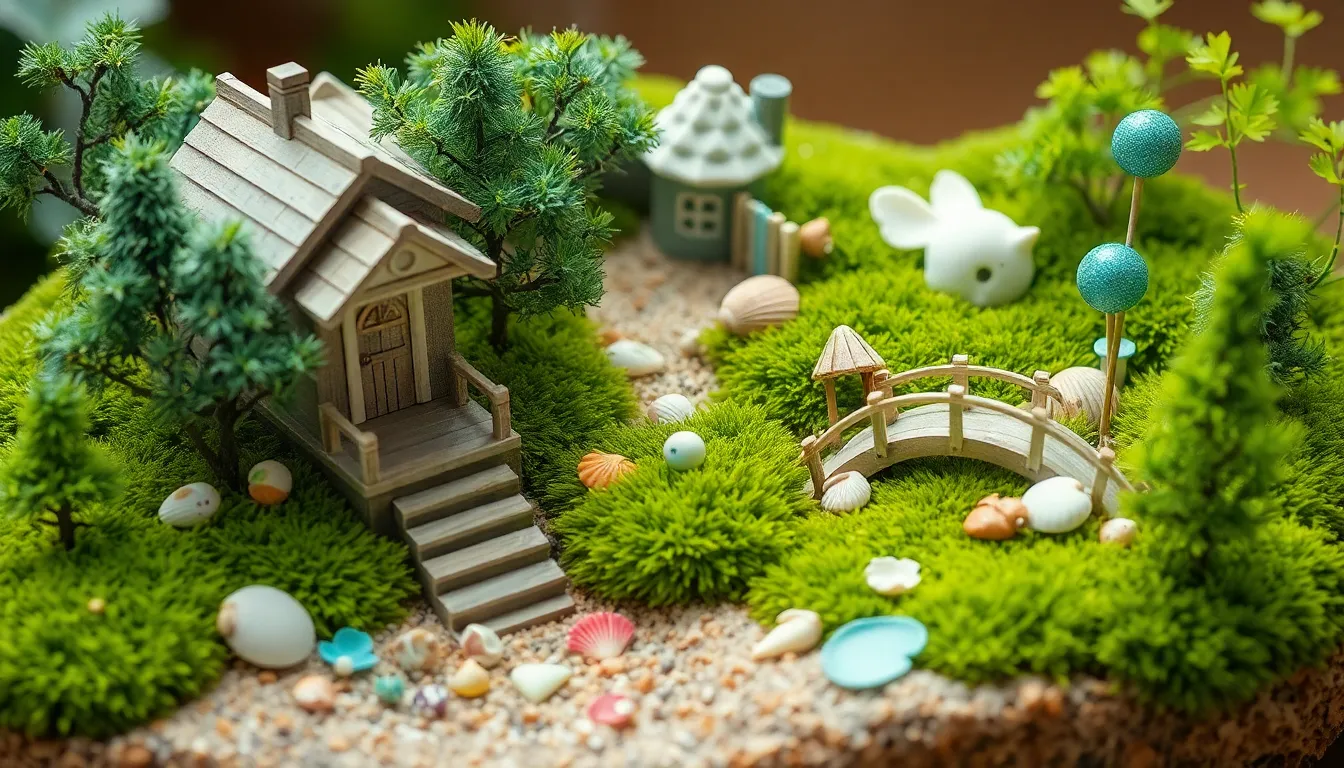
Transform your miniature garden into a whimsical wonderland by incorporating magical elements that spark imagination and create enchanting displays.
Enchanted Forest Themes
Mossy environments form the foundation of mystical forest gardens that transport viewers to magical woodland realms. Create depth by layering different moss varieties around small trees and tucking miniature pathways between the greenery for hidden discoveries.
Miniature arbors serve as perfect entrance points to your enchanted industry while small bridges spanning dry stream beds add architectural interest and storytelling elements. Position these structures strategically to guide the eye through your forest industry and create natural focal points.
Whimsical accessories like tiny birdhouses nestled among branches and small gazing balls reflecting light throughout the space enhance the magical atmosphere. We recommend placing these elements at varying heights to create visual layers that make your forest theme feel authentically wild and mysterious.
Beach and Coastal Fairy Gardens
Seashells collected from beach visits become the perfect decorative elements for coastal themed miniature gardens that capture seaside charm. Scatter various shell sizes throughout your design and use small pebbles to create natural looking pathways that mimic shoreline textures.
Sandy substrates work beautifully as ground cover when combined with drought tolerant plants like sedums and sempervivums that thrive in coastal conditions. These hardy succulents require minimal water while providing interesting textures and colors that complement beach themes perfectly.
Miniature beach houses or tiny lighthouses serve as charming focal points that immediately establish your coastal story. Position these structures near the back of your container to create depth while leaving open “beach” areas in the foreground for shell and pebble arrangements.
Modern Minimalist Fairy Gardens
Clean geometric lines define contemporary fairy gardens that embrace simplicity while maintaining magical appeal through thoughtful design choices. Use gravel pathways with straight edges and select containers with modern silhouettes to establish your minimalist foundation.
Dwarf conifers provide structure and year round interest without overwhelming small spaces or competing with your garden’s clean aesthetic. Pair these evergreens with compact hostas that offer contrasting leaf textures while maintaining the simplified plant palette essential for minimalist designs.
Natural hardscaping materials like small stone patios or slate stepping stones add functional beauty without cluttering your design. We suggest limiting decorative elements to one or two carefully chosen pieces that enhance rather than distract from your garden’s serene, uncluttered atmosphere.
Succulent Garden Ideas for Miniature Garden Displays
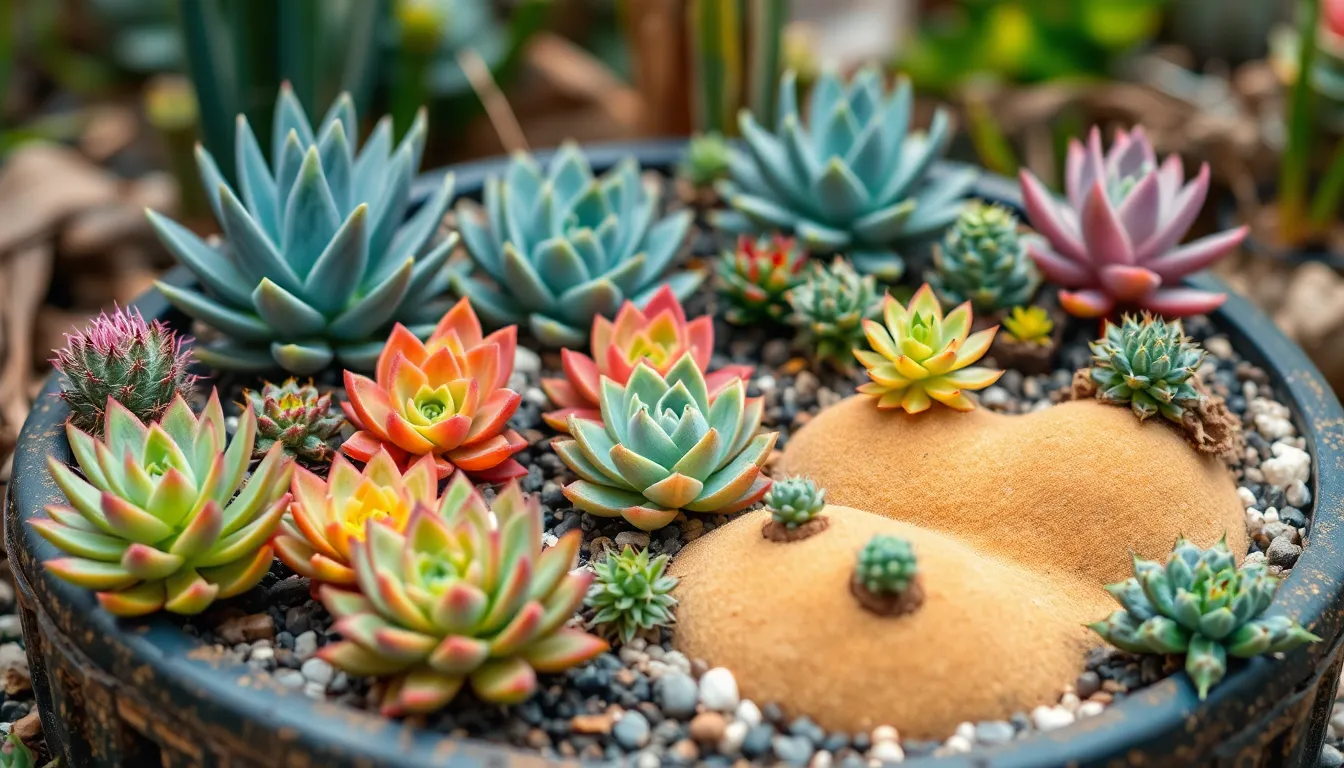
Succulents bring remarkable versatility to miniature garden displays with their diverse shapes, colors, and low-maintenance requirements. We’ll explore how these hardy plants can transform your compact space into stunning themed landscapes.
Desert Industry Miniatures
Miniature sand dunes create authentic desert scenes using fine sand paired with small cacti or succulents. Position these dunes at varying heights to mimic natural desert terrain, allowing your succulents to emerge as focal points throughout the industry.
Rock formations add dramatic structure to desert miniatures using small rocks and pebbles arranged in natural clusters. Layer different sized stones to create depth while providing perfect drainage conditions that succulents thrive in.
Succulent roofs transform miniature houses into living structures by using succulent cuttings as natural roofing material. This technique adds whimsical charm while creating functional growing spaces that blend seamlessly with desert themes.
Geometric Succulent Arrangements
Geometric patterns showcase succulents in structured designs like squares, circles, or triangles that create visual interest through repetition. Arrange identical succulent varieties in these shapes to emphasize the geometric effect while maintaining clean lines.
Symmetrical designs balance your miniature garden using paired succulent arrangements that mirror each other across a central axis. Choose succulents with similar growth habits to maintain symmetry as they mature and develop.
Linear arrangements guide the eye through your miniature space using rows of graduated succulent sizes. Start with larger specimens and decrease to smaller varieties to create perspective and depth within geometric frameworks.
Colorful Succulent Combinations
Mixing colors creates vibrant displays by combining succulents with contrasting hues like bright green specimens paired with red or purple varieties. These combinations draw attention and create focal points that enhance the overall visual impact of your miniature garden.
Complementary colors produce striking visual effects using opposite color wheel pairings such as yellow with purple or blue with orange succulents. This technique maximizes color contrast while maintaining harmony throughout your display.
Gradient arrangements transition smoothly between similar colors by positioning succulents in a spectrum from light to dark shades. Start with pale green varieties and progress through deeper tones to create sophisticated color flow in your miniature industry.
Herb Garden Ideas for Miniature Garden Functionality
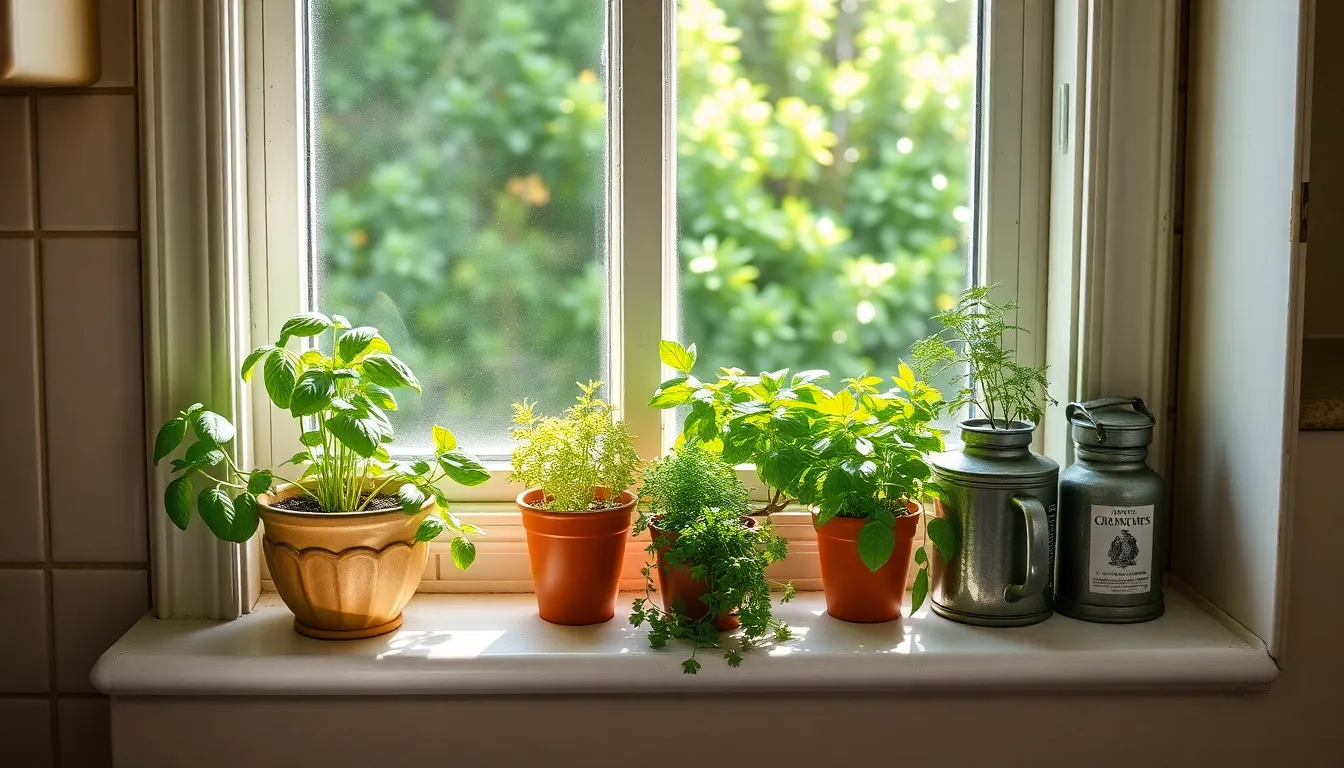
Functional miniature gardens serve dual purposes by combining beauty with practicality. Here’s how we can transform small spaces into productive herb gardens that enhance both our kitchens and our homes.
Kitchen Windowsill Herb Gardens
Windowsill herb gardens offer the perfect solution for accessing fresh herbs while cooking. We can create these gardens by placing small collections of herbs directly on kitchen windowsills where they’ll receive natural light throughout the day.
Positioning matters significantly when establishing windowsill herb gardens. Place containers near south-facing windows to maximize sunlight exposure, ensuring herbs like basil and oregano thrive in their compact environment.
Container selection becomes crucial for windowsill success. Use shallow ceramic bowls or small terra cotta pots that fit comfortably on narrow windowsills without blocking natural light from entering the kitchen.
Maintenance remains simple with proper plant choices. Choose herbs that require similar watering schedules and light conditions to create a cohesive windowsill garden that’s easy to care for daily.
Compact Culinary Herb Collections
Culinary herb collections maximize flavor variety within minimal space constraints. We can grow essential cooking herbs like basil, thyme, and rosemary in small pots or planters that fit on countertops or small outdoor areas.
Grouping strategies enhance both functionality and aesthetics. Arrange herbs by cooking frequency, placing frequently used varieties like parsley and chives in easily accessible front positions while positioning specialty herbs like sage behind them.
Container coordination creates visual harmony in compact spaces. Use matching planters or repurpose vintage containers to house different herb varieties while maintaining a cohesive look throughout the collection.
Harvesting techniques ensure continuous growth in small spaces. Pinch herbs regularly from the top to encourage bushy growth patterns that keep plants compact while providing steady harvests for cooking needs.
Medicinal Herb Mini Gardens
Medicinal herb gardens bring therapeutic benefits to miniature garden settings. We can incorporate herbs with healing properties such as chamomile and mint to create wellness-focused displays that serve both decorative and practical purposes.
Plant selection focuses on herbs with proven medicinal benefits. Include chamomile for its calming properties, mint for digestive support, and lavender for stress relief in compact arrangements that promote well-being.
Specialized containers protect delicate medicinal herbs. Use deeper pots with excellent drainage for herbs like echinacea and lemon balm that require more root space than typical culinary varieties.
Seasonal planning extends the medicinal garden’s usefulness year-round. Plant cool-season herbs like calendula alongside warm-season varieties to ensure continuous access to healing herbs throughout different seasons.
Terrarium Ideas for Miniature Garden Ecosystems
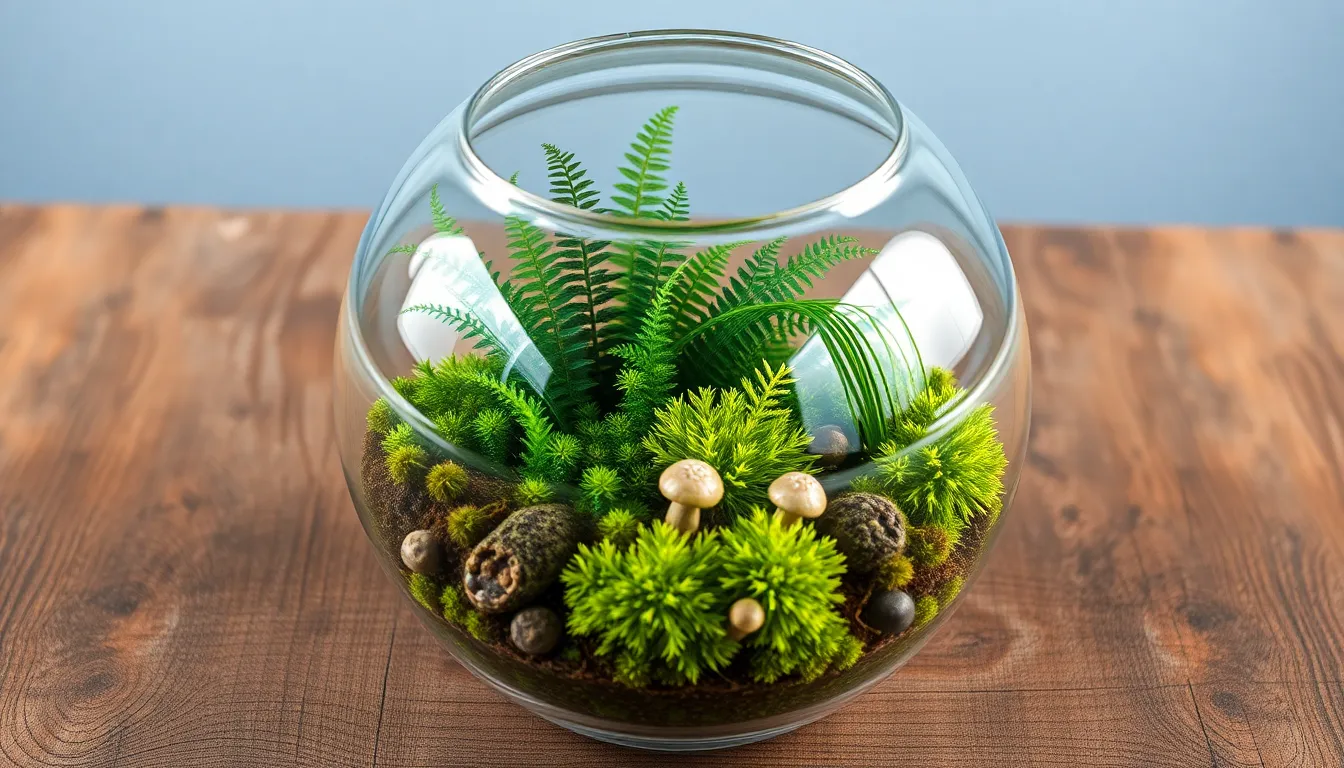
Terrariums offer a perfect way to create self-contained miniature ecosystems that bring nature indoors. These glass-enclosed gardens provide controlled environments where we can experiment with different plant combinations and themes.
Closed Terrarium Tropical Gardens
Closed terrariums create humid, tropical environments that support lush plant growth through natural moisture recycling. We recommend using ferns and mosses as the foundation plants since they thrive in high humidity conditions and create that authentic tropical atmosphere. These systems work by trapping moisture inside the glass container, where it evaporates from the soil and plant leaves, then condenses on the glass walls before dripping back down to nourish the plants.
Tropical closed terrariums excel at maintaining consistent moisture levels without daily watering requirements. We suggest layering different textures by combining delicate ferns with thick, velvety mosses to create visual depth. Adding small decorative elements like miniature mushrooms or tiny figurines enhances the mystical forest feeling while maintaining the tropical theme.
Open Terrarium Desert Scenes
Open terrariums work best for desert landscapes since they provide the excellent drainage and air circulation that cacti and succulents require. We create these arid scenes by incorporating various cacti species alongside drought-tolerant succulents to mimic authentic desert environments. The open design prevents moisture buildup that could harm these water-sensitive plants.
Desert terrariums benefit from strategic rock placement that creates natural-looking formations while improving drainage. We recommend using different sized stones to build miniature mesas and canyon walls that add dramatic height variations. Sand and gravel layers help complete the desert aesthetic while ensuring proper water drainage around plant roots.
Seasonal Terrarium Displays
Seasonal terrarium displays let us change our miniature garden themes throughout the year using interchangeable decorative elements. Winter displays feature evergreen branches and snow-white decorations that create a peaceful, frosty atmosphere inside the glass container. We achieve this look by adding white sand, small pine cones, and miniature winter accessories.
Spring terrariums incorporate blooming flowers and pastel colors that celebrate renewal and growth. We use small flowering plants alongside light-colored decorative stones and tiny spring-themed figurines. Summer displays feature bright flowers and lush greenery that capture the season’s vibrant energy through colorful plant selections and sunny decorative accents.
Autumn terrariums showcase warm-toned decorations and fallen leaves that reflect the season’s cozy atmosphere. We create these displays by adding amber and orange colored elements alongside plants that echo fall foliage colors.
Zen Garden Ideas for Miniature Garden Meditation
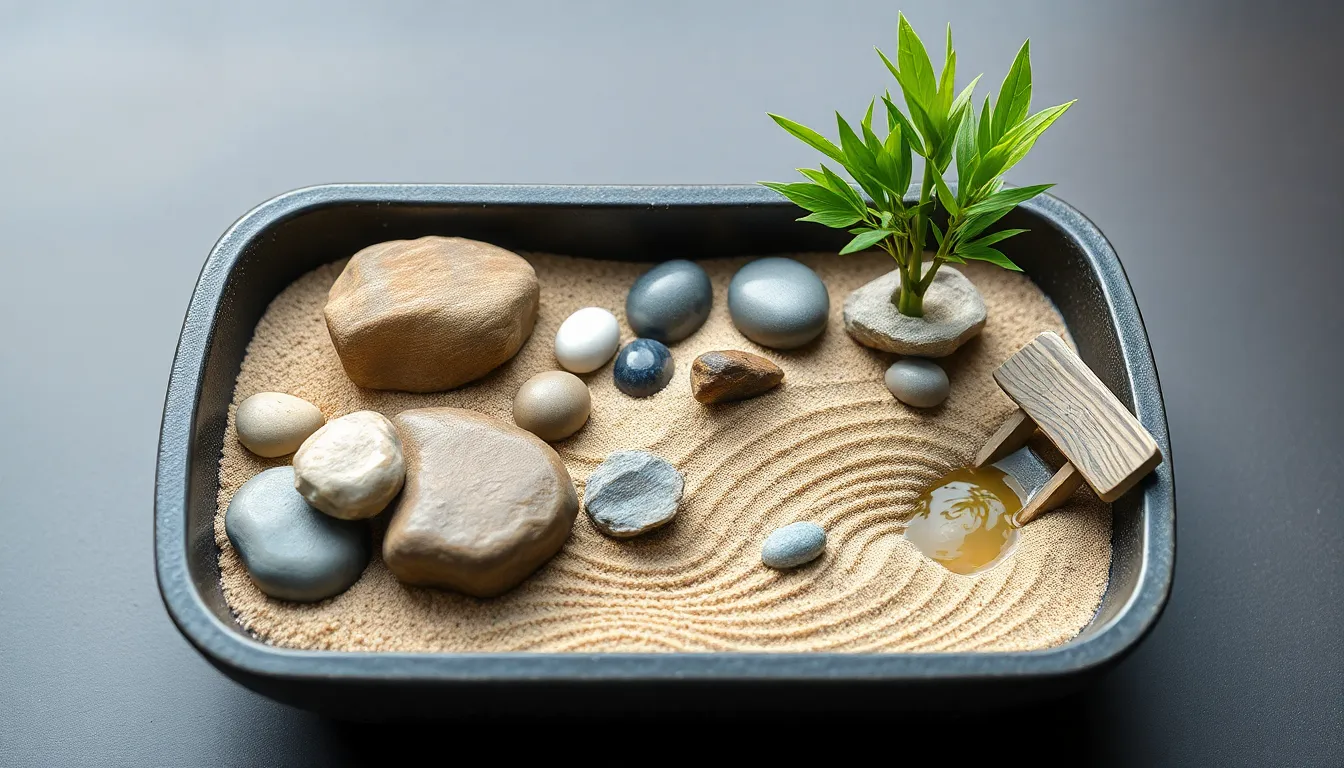
Creating a peaceful zen garden in miniature form brings the tranquil essence of Japanese meditation spaces directly into our homes. We can transform any shallow container into a calming sanctuary that promotes mindfulness and relaxation.
Japanese-Inspired Rock Gardens
Rock placement becomes the foundation of our miniature zen garden design. We position larger rocks as focal points throughout the space, then surround them with smaller stones to create visual balance and natural flow.
Material choice significantly impacts the overall aesthetic of our garden. Rough rocks provide a more natural and organic appearance, while smooth pebbles deliver a formal and refined look that emphasizes simplicity.
Color consideration plays a crucial role in maintaining the peaceful atmosphere. We select rocks with lighter hues to preserve the light and airy feeling that’s essential to traditional zen garden design.
Sand and Stone Arrangements
Design variety allows us to express creativity while maintaining zen principles. We can create intricate patterns in the sand using a small rake, or we might choose to leave stones in their natural arrangements for a more organic feel.
Material mixing enhances the visual appeal of our miniature meditation space. We combine different textures and colors thoughtfully, ensuring each element contributes to the overall harmony rather than creating visual chaos.
Pattern creation becomes a meditative practice in itself. Using a small rake, we draw flowing lines, circular motifs, or geometric designs in the sand or gravel surface, allowing the process to become part of our mindfulness routine.
Bamboo and Water Features
Miniature bamboo plants add authentic Japanese inspiration to our zen garden. We incorporate small bamboo varieties that maintain appropriate scale while bringing the natural vertical elements that are traditional in Japanese garden design.
Water features introduce soothing sounds that enhance the meditative experience. We can add a small fountain or water element that creates gentle bubbling or trickling sounds, transforming our miniature space into a true sanctuary for relaxation and contemplation.
Theme-Based Ideas for Miniature Garden Creativity
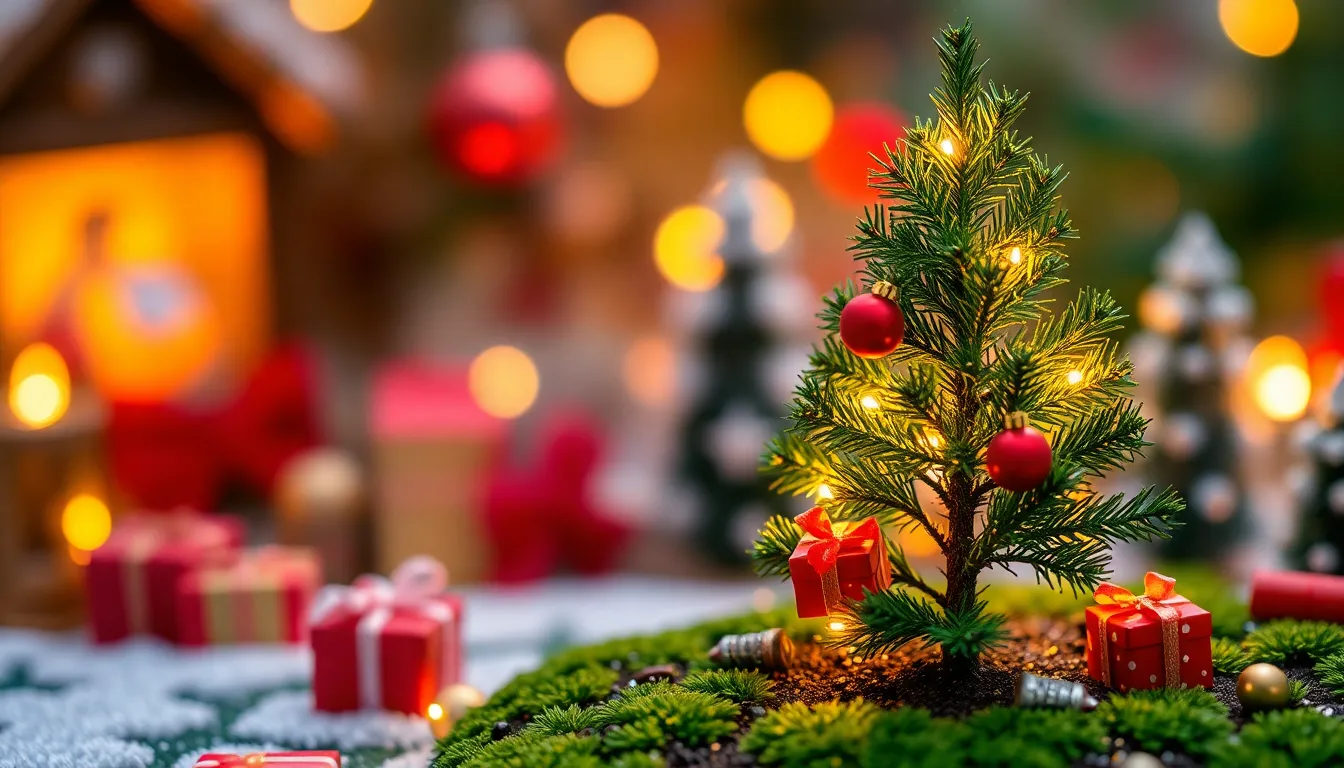
We’ll explore themed approaches that transform ordinary miniature gardens into extraordinary storytelling landscapes. These creative concepts help us design gardens that reflect our interests, memories, and cultural connections.
Seasonal Holiday Gardens
Christmas Mini Gardens capture festive magic through miniature evergreens, red and green accessories, and tiny gift boxes that create a winter wonderland atmosphere. We recommend incorporating small LED lights for subtle illumination that mimics twinkling holiday decorations. Traditional Christmas colors work best when balanced with natural green foliage from dwarf conifers or small ivy plants.
Halloween Gardens embrace spooky seasonal charm using miniature pumpkins, ghost figures, and autumn colored plants like sedum or hens and chicks for dramatic displays. Orange marigolds and purple pansies provide natural seasonal colors that complement decorative elements. We suggest adding tiny tombstones or skeleton figures nestled among fall foliage for authentic Halloween ambiance.
Independence Day Gardens showcase patriotic themes through red, white, and blue flowers combined with tiny flags for celebratory displays. White alyssum, red impatiens, and blue lobelia create natural flag inspired color schemes. Small American flags or star shaped decorations complete these themed gardens perfectly.
Movie and Book-Inspired Gardens
Book Inspired Gardens recreate beloved literary settings by selecting favorite stories and designing landscapes that mirror fictional environments. We choose props and plants that reflect each story’s unique atmosphere, whether it’s a secret garden with climbing vines or an enchanted forest with moss covered stones. Classic fairy tales like “Jack and the Beanstalk” inspire vertical gardens with climbing plants and tiny houses.
Movie Scene Gardens bring iconic film landscapes to life through careful plant selection and themed accessories. Hobbit hole recreations for “The Lord of the Rings” feature round doorways, rolling hills created with moss, and miniature vegetables in tiny garden plots. “Harry Potter” inspired gardens incorporate magical castle figurines, potion bottle planters, and plants that evoke the mysterious Hogwarts grounds.
Cultural and Regional Garden Themes
Japanese Zen Gardens evoke peaceful traditional landscapes using sand, carefully placed rocks, and miniature maple trees for authentic meditation spaces. We arrange elements according to zen principles, creating flowing patterns in sand that represent water movement. Small bamboo features or tiny pagodas enhance the cultural authenticity while maintaining the garden’s serene atmosphere.
Desert and Mediterranean Gardens showcase drought tolerant beauty through succulents, decorative gravel, and tiny terracotta pots that reflect arid region aesthetics. Lavender, rosemary, and small olive tree varieties create Mediterranean herb gardens with authentic regional character. We incorporate sun bleached stones and weathered pottery to enhance the natural desert or coastal Mediterranean appearance.
Indoor Ideas for Miniature Garden Year-Round Enjoyment
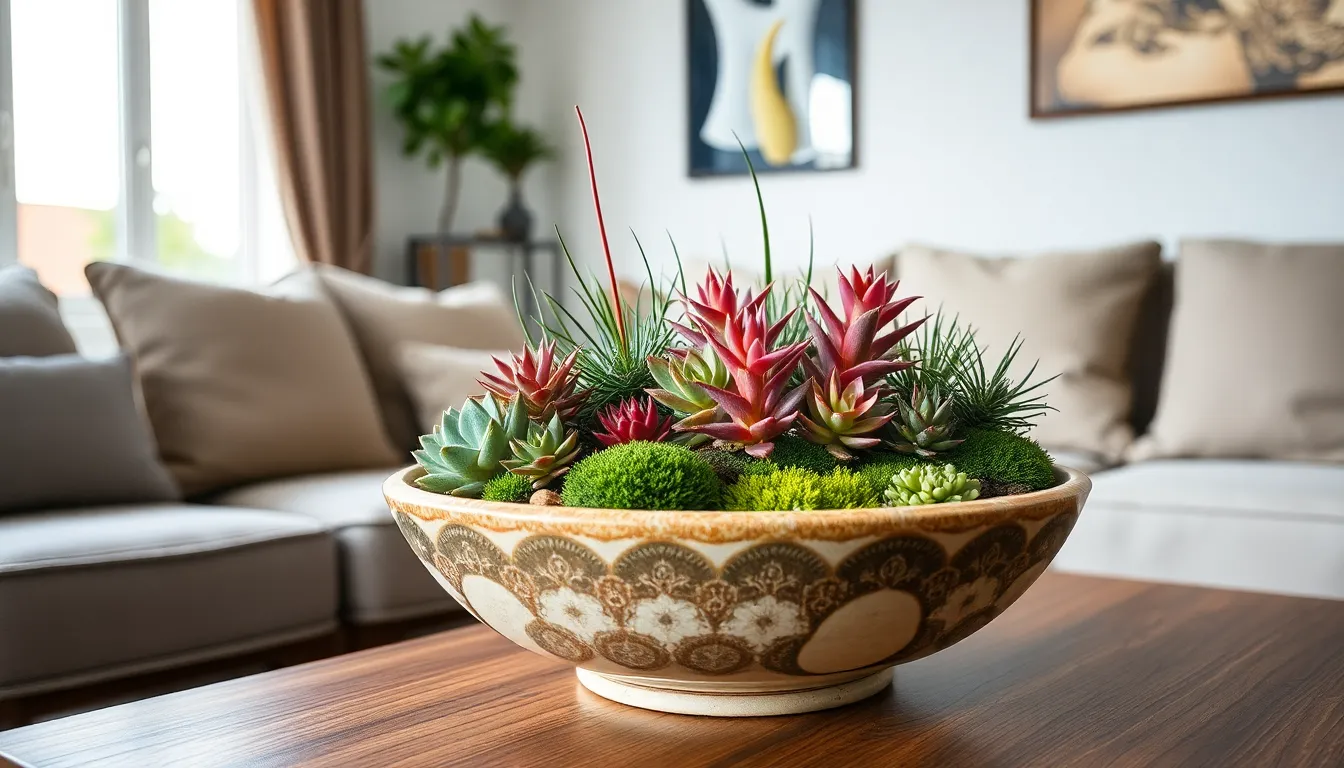
We can transform any indoor space into a green sanctuary with miniature gardens that thrive throughout the seasons. These compact displays bring nature’s beauty inside while adapting to different room environments and lighting conditions.
Living Room Display Gardens
Decorative containers create stunning focal points for our living room miniature gardens. We recommend using decorative cachepots, shallow ceramic dishes, or elegant glass bowls that complement our existing décor while providing adequate space for plant growth.
Themed walkway designs add character and visual interest to these display gardens. We can incorporate miniature pathways using small pebbles, create tiny arches with wire or wood, and position small decorative statues to establish a cohesive garden story.
Easy care plant combinations ensure our living room gardens remain beautiful with minimal maintenance. We suggest pairing small succulents with air plants, combining different textures of moss, or grouping dwarf varieties of houseplants that share similar light and water requirements.
Strategic placement maximizes the visual impact of our living room miniature gardens. We position these displays on coffee tables, side tables, or floating shelves where they receive adequate natural light while serving as conversation starters for guests.
Bathroom Humidity-Loving Plants
Ferns and mosses thrive in our bathroom’s naturally humid environment, creating lush green miniature landscapes. We choose varieties like button ferns, baby tears, or sheet moss that absorb moisture from shower steam and maintain their vibrant appearance year-round.
Air plants offer unique sculptural elements while requiring minimal soil space in our bathroom miniature gardens. We mount these moisture-absorbing plants on driftwood, arrange them in glass orbs, or nestle them among decorative stones where they’ll flourish in the humid air.
Container drainage becomes crucial for bathroom miniature gardens to prevent water accumulation. We use shallow dishes with drainage holes, add pebble layers for excess water management, or select containers that allow air circulation around plant roots.
Low light adaptations help our bathroom gardens succeed in spaces with limited natural light. We incorporate plants that tolerate indirect lighting, supplement with small LED grow lights, or rotate our miniature gardens periodically to brighter locations.
Bedroom Air-Purifying Gardens
Snake plants remove indoor pollutants while requiring minimal care in our bedroom miniature gardens. We select dwarf varieties that fit compact containers, position them near windows for optimal light, and appreciate their air-cleaning benefits during sleep hours.
Spider plants provide both visual appeal and air purification qualities for our bedroom displays. We choose small specimens that produce cascading plantlets, arrange them in hanging containers, or group multiple plants in shallow planters for maximum air-cleaning impact.
Nighttime oxygen production makes certain plants ideal for our bedroom miniature gardens. We include plants like peace lilies, rubber plants, or aloe vera that continue releasing oxygen after dark, contributing to better air quality while we sleep.
Maintenance scheduling keeps our bedroom miniature gardens healthy without disrupting our rest routine. We establish weekly watering schedules, monitor plant health during morning light, and perform any necessary pruning or repotting during daytime hours when we’re not sleeping.
Outdoor Ideas for Miniature Garden Weather Resistance
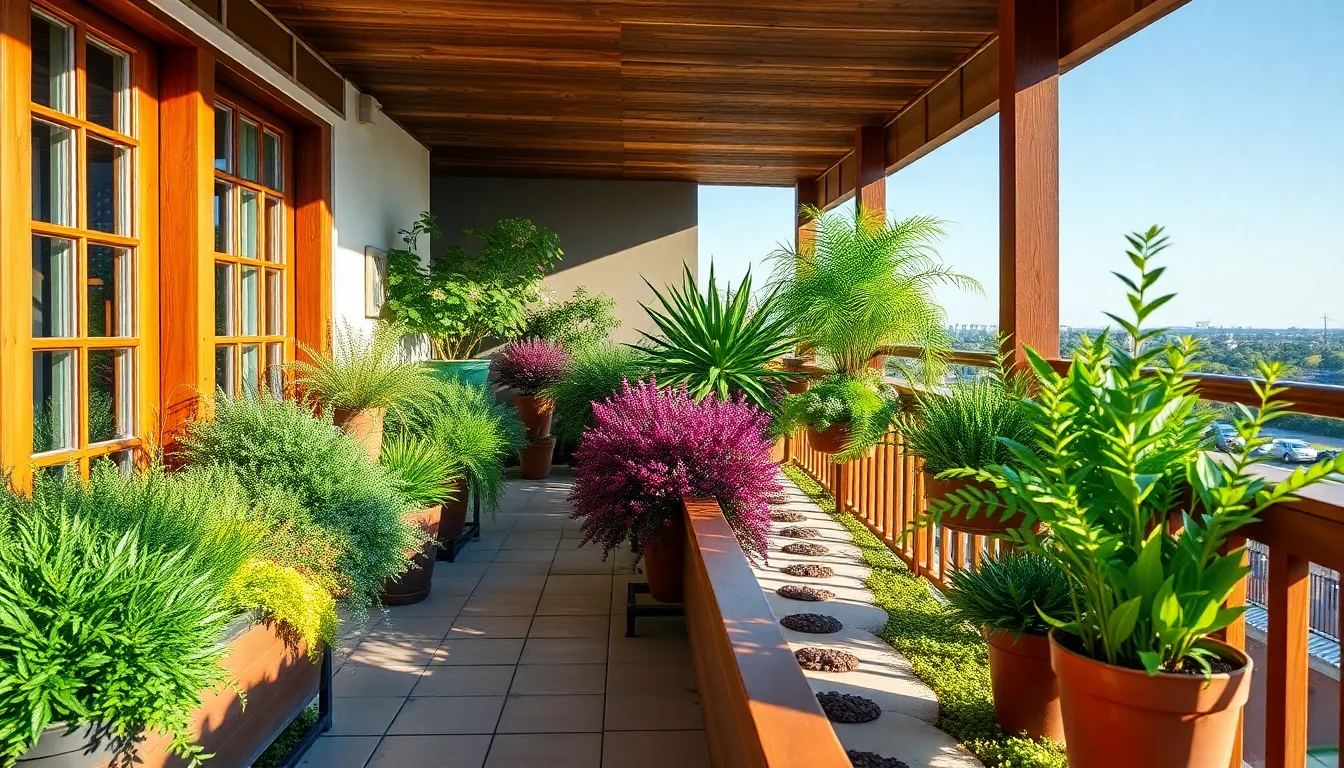
Creating outdoor miniature gardens requires strategic planning to ensure they withstand the elements while maintaining their charm. We’ll explore proven methods for building resilient outdoor displays that thrive in various weather conditions.
Balcony and Patio Gardens
Container gardening transforms balconies and patios into miniature garden havens that can weather seasonal changes. We recommend filling containers with good potting soil and arranging plants like ajugas, creeping thymes, and sedums for visually appealing designs that tolerate outdoor conditions.
Meandering pathways add charm to these compact spaces while serving practical purposes. Small accessories like stepping stones guide visitors through your garden while providing stable surfaces that resist weather damage.
Strategic plant selection ensures year-round beauty in confined outdoor spaces. Plants like trailing rosemary and wire vine thrive in containers while offering durability against varying weather conditions throughout the seasons.
Garden Bed Border Miniatures
Border planting with naturally miniature plants creates seamless transitions between full-size gardens and compact displays. We suggest using small grasses, mosses, and miniature alpines that maintain proper scale while requiring minimal weather protection.
In-ground miniature gardens offer permanent answers for weather-resistant outdoor displays. These installations integrate naturally with existing landscapes while providing stability that container gardens cannot match during severe weather events.
Scale maintenance becomes effortless when we select plants that naturally stay small rather than requiring constant pruning. This approach reduces maintenance while ensuring your garden maintains its proportions through changing seasons.
Weatherproof Container Gardens
Protective measures extend the lifespan of outdoor miniature gardens through careful container selection and placement strategies. We recommend using weatherproof containers that resist cracking from freeze-thaw cycles while providing adequate drainage for plant health.
Winter protection requires removing accessories before snowfall and storing them safely indoors to prevent weather damage. This simple practice preserves decorative elements while allowing plants to focus their energy on surviving harsh conditions.
Insulation techniques help container gardens survive extreme temperatures without requiring indoor storage. We suggest wrapping containers or moving them to protected areas during severe weather while maintaining their outdoor placement during moderate conditions.
Budget-Friendly Ideas for Miniature Garden Projects

Creating stunning miniature gardens doesn’t require very costly or investing in expensive materials. Smart shopping and creative repurposing can help us build enchanting displays while keeping costs minimal.
DIY Materials and Supplies
Reclaimed wood serves as our foundation for building miniature bridges and walkways that add rustic charm to any display. We can find these materials at construction sites, old furniture pieces, or community recycling centers at little to no cost.
Small potted plants with delicate features like baby succulents, Irish moss, and miniature daisies provide the perfect scale for our projects without the premium price of specialty fairy garden plants. Local nurseries often sell these varieties in affordable starter pots.
Natural elements from our surroundings including pinecones, acorns, and small stones create texture and visual interest while costing absolutely nothing. We can gather these materials during nature walks or from our own backyard spaces.
Broken clay garden finials transform into unique planters when we repurpose them creatively, giving damaged items a second life in our miniature landscapes. Thrift stores and garage sales often have these pieces at fraction of retail prices.
Propagation and Plant Swapping
Plant propagation multiplies our collection through simple techniques like cutting succulents or dividing creeping thyme clumps. We can create dozens of new plants from a single parent plant within just a few weeks.
Neighborhood plant swaps diversify our gardens through community exchanges where we trade cuttings, seeds, or small plants with fellow gardening enthusiasts. These events cost nothing but provide access to varieties we might never have purchased.
Succulent leaf propagation generates endless supplies of tiny plants perfect for miniature garden scales. We simply place fallen leaves on soil and watch them develop roots and new growth over several months.
Friend networks expand our plant options when we ask fellow gardeners to share divisions from their established perennials or herbs. Most gardeners eagerly share excess plants rather than composting them.
Upcycled Garden Decorations
Household items transform into miniature structures when we repurpose old jars, bottles, and cookie jars as fairy houses or decorative elements. We can paint these containers or wrap them with natural materials for authentic appearances.
Teapots and wooden boxes become charming planters that add whimsical character to our displays while preventing usable items from reaching landfills. These containers often provide better drainage and root space than traditional pots.
Beach treasures like shells and driftwood create coastal themed decorations that bring natural beauty to our miniature landscapes. We can collect these materials during vacation trips or local beach visits.
Kitchen utensils serve multiple purposes as miniature garden tools, plant markers, or decorative elements when we think creatively about their potential uses. Old spoons become tiny shovels while cork stoppers transform into mushroom decorations.
Conclusion
We’ve explored countless ways to bring the magic of gardening into even the smallest spaces through miniature gardens. From repurposed household containers to elaborate themed displays these tiny landscapes offer endless creative possibilities that fit any lifestyle and budget.
Whether you’re drawn to zen meditation spaces or whimsical fairy gardens the key lies in choosing elements that reflect your personal style. Indoor options provide year-round enjoyment while outdoor miniature gardens connect us with nature’s seasonal rhythms.
The beauty of miniature gardening isn’t just in the final display—it’s in the therapeutic process of creating something meaningful with your own hands. These small-scale gardens prove that size doesn’t limit our ability to cultivate beauty and find peace in nature.
Start small experiment with different themes and watch your miniature garden grow into a source of daily joy and inspiration.
Frequently Asked Questions
What exactly is a miniature garden?
A miniature garden is a compact gardening solution that fits in small spaces like windowsills, tabletops, or glass containers. These tiny landscapes can range from fairy tale scenes to zen-inspired succulent arrangements, offering the joy of gardening without requiring large outdoor spaces. They provide both aesthetic appeal and therapeutic benefits while being perfect for apartment living or limited garden areas.
What containers work best for miniature gardens?
You can use both traditional and repurposed containers for miniature gardens. Traditional options include shallow ceramic bowls and terra cotta pots for optimal plant health. Creative alternatives include vintage teacups, old colanders, wooden drawers, and hanging planters. The key is ensuring proper drainage and choosing containers that complement your garden’s theme and growing conditions.
Can I grow herbs in a miniature garden?
Yes! Herb gardens are excellent for miniature displays, combining beauty with practicality. Kitchen windowsill herb gardens work perfectly with proper positioning and container selection. You can create compact culinary collections that maximize flavor variety in small spaces, or even grow medicinal herbs with therapeutic properties for year-round access to healing plants.
What plants work best for indoor miniature gardens?
Indoor miniature gardens thrive with low-maintenance plants suited to specific rooms. For living rooms, use decorative containers with easy-care plant combinations. Bathrooms benefit from humidity-loving plants like ferns and air plants. Bedrooms work well with air-purifying plants such as snake plants and spider plants that require minimal maintenance.
How do I create a terrarium for my miniature garden?
Terrariums create self-contained ecosystems perfect for miniature gardens. Use closed terrariums with ferns and mosses for tropical environments that love humidity. Open terrariums work better for desert scenes with cacti and succulents, providing proper drainage and air circulation. Consider seasonal themes with appropriate decorative elements for year-round visual interest.
Can miniature gardens survive outdoors?
Yes, but outdoor miniature gardens require strategic planning for weather resistance. Use weatherproof containers and select resilient plants like ajugas and creeping thymes for balconies and patios. Consider winter protection techniques and insulation methods to ensure longevity. Border planting with miniature plants can seamlessly integrate with larger garden spaces.
How can I create a miniature garden on a budget?
Budget-friendly miniature gardens focus on smart shopping and creative repurposing. Use reclaimed wood for structures, propagate plants from cuttings, and participate in neighborhood plant swaps. Incorporate natural elements like pinecones and stones for texture. Transform household items, beach treasures, and kitchen utensils into unique decorative elements through upcycling.
What themes work well for miniature gardens?
Popular themes include enchanted forests with moss and miniature arbors, coastal gardens using seashells and drought-tolerant plants, and modern minimalist designs with clean lines. You can also create zen meditation gardens, seasonal holiday displays, movie-inspired landscapes, or cultural themes like Japanese or Mediterranean gardens reflecting personal interests and regional aesthetics.

